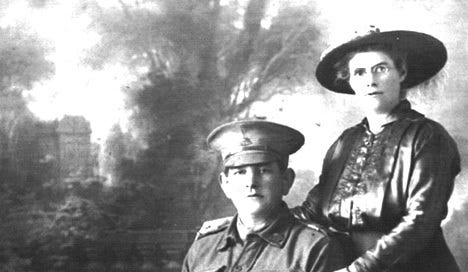My grandfather Archie Baxter and wife Stella, just before he sailed for France in 1914.
Australia has two national days. Australia Day – 26 January - is ignored by most people, but the second – Anzac Day, 25 April: today - is a much more raucous occasion. Veterans and the military in general parade through most cities. In many towns, people gather at the cenotaph that celebrates those who died for their country. A bugler plays the Last Post – the American Taps – and there are readings of Lawrence Binyon’s poem For the Fallen.
They shall grow not old, as we that are left grow old:
Age shall not weary them, nor the years condemn.
At the going down of the sun, and in the morning
We will remember them.
Curiously, the campaign being celebrated, Australia’s first in a world war, was a military disaster. In 1916, the British, hoping to draw the Germans away from the trench war in France, opened a “second front” against their allies, the Turks, on the Gallipoli Peninsula. It aimed to seize the Dardanelles and eventually capture Constantinople. British troops being otherwise occupied, the Australian and New Zealand Army Corps – Anzacs - were sent in, and, after a bloody few months, driven back with enormous losses.
Over the years, the militarism of Anzac Day, and in particular the practice of parading, has come in for much criticism, and some spirited defence. Armies back to the Romans, say its supporters, have paraded to celebrate their return from a war. Yes, say the detractors, but only once, not every year – and only if they won.
Win or lose, what’s really being celebrated is that for which every serviceperson strives – survival, and the chance to enjoy the pleasures of peace. Hence the excess consumption of beer on Anzac Day, to which the police turn a blind eye, and the ritual playing of a game called Two-Up.
As simplistic as a nursery game, Two-up has an inexhaustible appeal to Australians at war. Two coins are flipped in the air, and bets laid on whether they land heads or tails uppermost. With its blanket spread on the floor, two big copper pennies with their “tails” sides marked with a white cross for easy identification, the wooden “kip” used to flip them, a “cockatoo” to keep watch, and the ritual shouts of “Come in, spinner!”, the clandestine Two-Up school is as emblematic of Australian service life as the American Craps.
Our family doesn’t have much of a military history. My grandfather – my father’s father – volunteered for the First World War and got as far as France, only to be sent back for health reasons, without firing a shot. It took him years to return home – the boat trip took 43 days - but at least he survived, to, indirectly, produce me, my sister and brother, and in turn our daughter…and so, I guess, there actually is a reason to celebrate. Come in, spinner! And the next beer’s on me.





Perhaps because it's at such schools one learns not to gamble.
Great rendering of the Two-Up school (why it's called a school I don't know)in Wake in Fright.